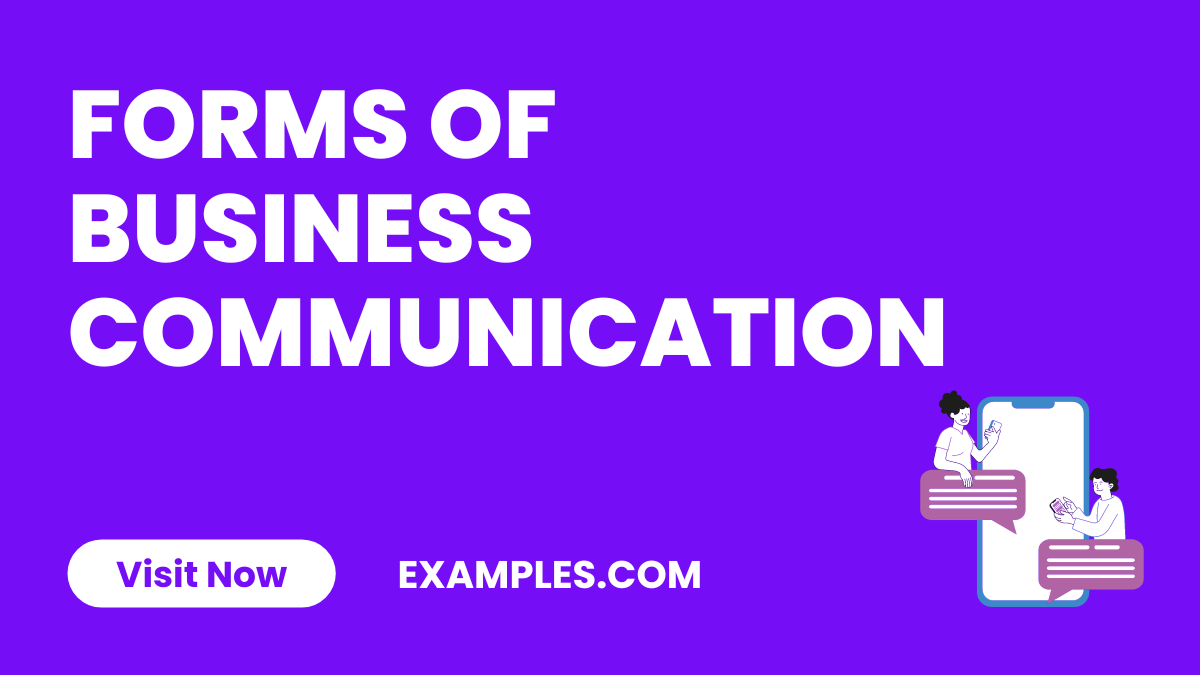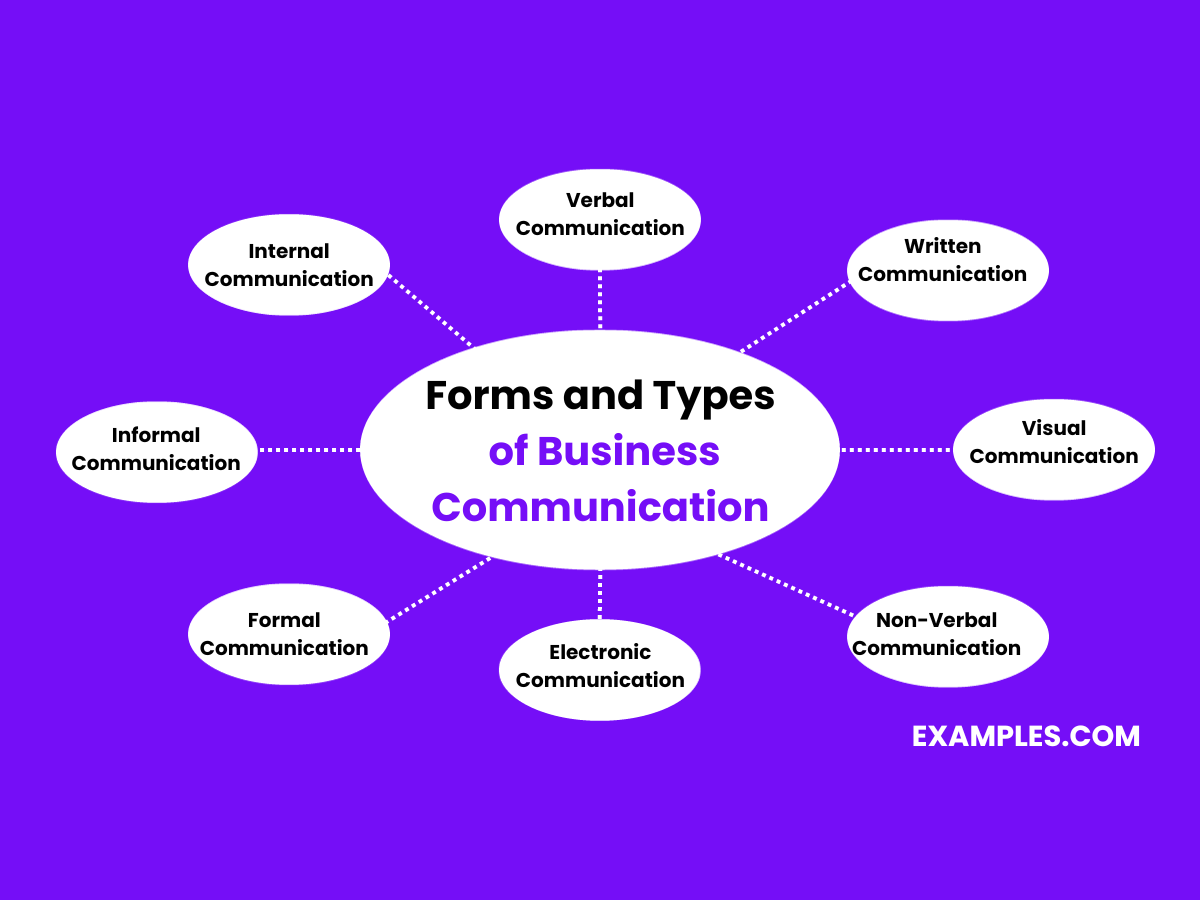10 Forms of Business Communication Examples
In the comprehensive guide Forms of Business Communication,you’ll explore various modes of corporate interactions, each with unique Communication Examples. This guide covers essential forms like verbal and non-verbal communication, including body language and gestures, to written methods like emails and reports. It also delves into modern electronic communication, highlighting how digital platforms have reshaped business dialogues. With practical examples, this guide offers valuable insights into effectively using each form to enhance workplace communication and achieve organizational goals.
Basic Forms of Business Communication
1. In-Person Meetings
- Allows for direct, interactive communication.
- Ideal for complex discussions and building relationships.
2. Business Emails
- Efficient for formal, documented communication.
- Used widely for both internal and external correspondence.
3. Phone Calls
- Suitable for quick, direct communication.
- Offers immediate feedback and clarification.
4. Video Conferencing
- Combines visual and verbal communication remotely.
- Useful for team meetings and client presentations.
5. Business Reports
- Provides detailed information and analysis.
- Essential for decision-making and record-keeping.
6. Memos
- Short, internal documents for quick updates.
- Ideal for brief announcements or instructions.
7. Newsletters
- Regular updates to employees or stakeholders.
- Builds community and keeps everyone informed.
8. Social Media Posts
- Engages a wider audience quickly.
- Useful for marketing and public relations.
9. Press Releases
- Formal announcements to the media.
- Communicates major company news or events.
10. Business Plans
- Outlines company goals and strategies.
- Crucial for securing investments and guiding growth.
Modern Forms of Business Communication
Modern forms of business communication have evolved with technology, focusing on speed, efficiency, and broader reach. These forms are designed to meet the dynamic needs of today’s business world, embracing digital platforms and interactive media.
1. Social Media Platforms
- Enables real-time engagement with customers and brand promotion.
- Platforms like LinkedIn, Twitter, and Facebook are widely used.
2. Video Conferencing Tools
- Facilitate virtual meetings, saving time and travel costs.
- Examples include Zoom, Microsoft Teams, and Google Meet.
3. Instant Messaging Apps
- Provide quick, informal communication among team members.
- Popular apps include Slack, WhatsApp, and Telegram.
4. Email Marketing Software
- Allows businesses to send targeted messages to large audiences.
- Tools like Mailchimp and Constant Contact are commonly used.
5. Project Management Tools
- Streamline collaboration and project tracking.
- Notable examples are Asana, Trello, and Monday.com.
6. Customer Relationship Management (CRM) Systems
- Help manage customer interactions and data.
- Salesforce and HubSpot CRM are key examples.
7. Content Management Systems (CMS)
- Assist in creating and managing digital content.
- WordPress and Joomla are popular choices.
8. Corporate Blogs
- Provide a platform for sharing insights and company news.
- Often integrated into company websites.
9. Webinars
- Used for online seminars, training, and presentations.
- Platforms like WebEx and GoToWebinar facilitate these.
10. Cloud Computing Services
- Enhance data storage, accessibility, and collaboration.
- Services like AWS and Google Cloud are widely utilized.
Different Types of Forms in Business Communication
Forms and types of business communication are vital for effective corporate interactions and can be broadly categorized as follows:
- Verbal Communication: Involves spoken words, crucial for meetings, presentations, and phone calls.
- Written Communication: Written Communication Includes emails, reports, and memos, providing a formal record of information exchange.
- Non-Verbal Communication: Non-Verbal Communication Body language, gestures, and facial expressions that complement or contradict verbal communication.
- Visual Communication: Visual Communication Utilization of visual aids like charts and graphs to support and clarify messages.
- Electronic Communication: Digital methods like social media, websites, and instant messaging for quick and broad communication.
- Formal Communication: Formal Communication Official business interactions, including formal meetings and official documents.
- Informal Communication: Informal Communication Casual interactions among colleagues, fostering relationship building and a relaxed environment.
- Internal Communication: Internal Communication within an organization, such as team meetings and internal emails.
Top forms of Effective Business Communication
Top forms of effective business communication are:
- Face-to-Face Meetings: Allows for personal interaction, immediate feedback, and clear understanding.
- Email Communication: Provides a formal, traceable, and convenient way to exchange information.
- Teleconferencing and Video Calls: Facilitate remote communication, saving time and resources.
- Presentations: Effective for conveying information to larger groups, often supported by visual aids.
- Reports and Documents: Offer detailed, structured information, essential for record-keeping and analysis.
- Instant Messaging and Chat Apps: Enable quick, informal communication, ideal for fast-paced environments.
What are The Key Forms of Business Communication Writing?
The key forms of business communication writing include:
- Business Emails: Formal and concise, used for daily communication.
- Reports: Detailed documents on specific topics, projects, or research.
- Proposals: Suggestions or plans, often for projects or agreements.
- Business Letters: Formal letters for external communication.
- Memorandums (Memos): Internal documents for sharing information within an organization.
- Business Plans: Detailed plans outlining business strategies and goals.
- Press Releases: Official statements to the media about company news or events.
- User Manuals/Guides: Instructional content for products or services.
What forms of Business Communication rely on the Internet?
- Email Communication: Essential for daily corporate correspondence.
- Video Conferencing: Tools like Zoom and Microsoft Teams for virtual meetings.
- Instant Messaging and Chat Apps: Slack, WhatsApp for quick team communication.
- Social Media Platforms: LinkedIn, Twitter for brand engagement and networking.
- Project Management Tools: Asana, Trello for collaborative project tracking.
- Customer Relationship Management (CRM) Systems: Salesforce, HubSpot CRM for managing customer interactions.
- Corporate Blogs and Websites: Online platforms for company news and insights.
- Cloud-Based Document Sharing: Google Drive, Dropbox for file sharing and collaboration.
- Online Marketing Tools: Digital advertising and email marketing campaigns.
- Webinars and Online Training: WebEx, GoToWebinar for virtual seminars and training sessions
Important Forms of Business Communication
Important forms of business communication include:
- Verbal Communication: Face-to-face meetings and phone calls. Essential for immediate feedback and understanding non-verbal cues.
- Written Communication: Emails, reports, and memos. Provides a clear, formal record of exchanges.
- Non-Verbal Communication: Body language and facial expressions. Enhances or contradicts verbal communication.
- Visual Communication: Use of charts, graphs, and slides. Helps in simplifying and explaining complex information.
- Electronic Communication: Digital platforms like social media and instant messaging. Offers quick and informal ways to communicate.
The article from Fivedash discusses the importance of choosing the right communication channels for successful business relationships. It emphasizes that both verbal and non-verbal cues are important in communication and that the effectiveness of a channel also depends on how it resonates with the audience. It covers different types of business communication channels, categorized into formal, informal, and unofficial, and explains how they cater to various needs and audiences. Additionally, the article provides insights on choosing the best communication channels for businesses and implementing them effectively.




